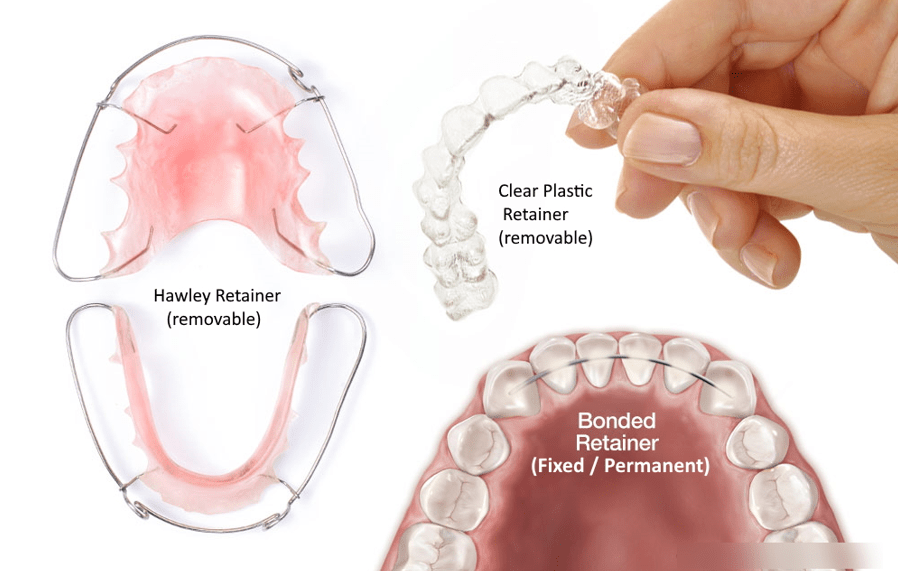
Doc, I have just completed my 18 months of treatment with braces, you are telling me to wear the retainers for another year, are you serious? The question that I get asked by a few of my patients who have not had the patience to listen to my ‘before the start of treatment’ briefing about the whole journey with braces.
What are retainers?
Retainers are appliances that are meant to retain the teeth in their new place, as the name indicates, they ‘retain’ the teeth. Most of the retainers do not have any capacity to move the teeth by even a small amount.
There are two major types – removable and fixed. Fixed retainers as the name indicates, are fixed to the back side of your teeth. They are made up of very thin wires that are attached with an adhesive to the back side of the teeth, its not visible to others, you have to look through a mirror at an angle to be able to see it yourself. You can eat with it, brush over it and almost do all your normal activities while still having them on.
The removable retainers on the other hand are removable, which are meant to be removed while eating, drinking and brushing. There are again two types of removable retainers –
- Clear retainers which are vacuum formed, fit over your teeth without extending much over your gums or other soft tissue, hardly noticeable at speaking distance, comfortable to wear. The only downside, they can break easily, it will demand careful handling.
- Hawley retainer – Has an acylic plate that covers a portion of the palate and has a wire that’s quite visible at speaking distance. Because of the acrylic and the wire components, they can be little uncomfortable in the initial couple of days. The bright side of it – quite durable, do not break easily (although I have had kids who have broken this retainer as well!!)

How important are retainers?
Well, I would say, it’s as important as your treatment with braces, if not more. Yes!. What’s the point of treatment if the results achieved are not stable? And retainers are the only way in which the achieved results can be stabilised, particularly if you have taken treatment in adulthood, let’s say after 18 yrs of age, when a large extent of your growth is complete. That’s another advantage of starting treatment early on in life (Please refer to my earlier article in this magazine – when is the right age to bring your child for an Orthodontic consult?)
Cannot take my word on this? – here is the reference from the American Association of Orthodontists (which is a highly reputed body of Orthodontists), please go through the link and understand what they have to say about retainers. Orthodontic Post-Treatment | Your Guide to Orthodontics (aaoinfo.org) If you would be interested to have the pdf document from AAO, pls email me on the address below and I shall gladly send it across to you.
Why are retainers necessary?
Teeth are moved from one place to another using braces or clear aligners like Invisalign, and when they are discontinued after the treatment is over, the teeth have a tendency to move back to its original place. Well, it might not move to its actual, original place, but they can potentially move. If this movement happens right in the front teeth, which is quite visible, are you willing to accept that change? Please understand any further correction will require treatment with braces, once again. Yes, you heard me right, you will have to start all over again. This is exactly the reason why I strongly recommend fixed retainers for upper and lower front teeth and removable upper and lower retainers over the fixed retainer, for a period of approximately one year after removal of braces (there are few cases which require longer wear, however.) The fixed retainers will stay for life, they are harmless, will become a part of your mouth and you will forget you even have it, after a couple of days. Even if you remove your fixed retainers after 5 years, your teeth can potentially move.
Can I have braces for an extended period, after completion of treatment and avoid the retainers?
Sorry, it’s a no. To achieve stability, a slight movement of teeth should be allowed in the new position and braces will not allow that to happen, hence retainers are mandatory.
To sum it up, if you are someone who is very particular and do not wish any unexpected movement of teeth after completion of treatment with braces, go for fixed retainers for upper and lower along with removable retainers for upper and lower teeth. On the other hand, if you don’t mind unexpected teeth movement after completion of braces, you may throw the retainers away! Life is all about choices and you clearly have a choice to make.
Dr Diwakar Raju, Specialist Orthodontist.


